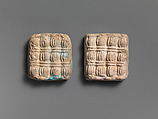Glass bead
Probably western Asiatic or Levantine
These beads probably belong to a type known as Nuzi beads, named after the site of Nuzi (present-day Yorgan Tepe, Iraq) where similar examples were discovered in the 1920s. Others have been found at sites across the ancient Near East, as well as at the Hittite capital of Hattusa (present-day Bogazkale, Turkey) and Mycenae in Greece. Made in the same mold, these two beads are the only known examples of this type from Cyprus.
Due to rights restrictions, this image cannot be enlarged, viewed at full screen, or downloaded.
This artwork is meant to be viewed from right to left. Scroll left to view more.



